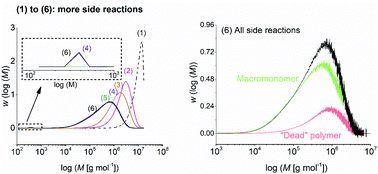Impact of side reactions on molar mass distribution, unsaturation level and branching density in solution free radical polymerization of n-butyl acrylate under well-defined lab-scale reactor conditions†
Abstract
The radical chemistry of polyacrylate synthesis is non-trivial, due to a significant amount of side reactions. Backbiting transforms conventional secondary end-chain radicals (ECRs) in less reactive tertiary mid-chain radicals (MCRs), leading to a decrease of the polymerization rate and short chain branch formation upon further propagation. β-Scission of MCRs at elevated temperature results in a decrease of the average chain length and the formation of unsaturated chains that act as macromonomers. Also chain transfer to polymer can take place, contributing to long chain branch (LCB) formation upon further propagation or termination. The relative importance of these side reactions depends not only on the solvent fraction because of the competition of uni- and bimolecular reactions but also on the reaction temperature with more activated reactions such as β-scission more promoted upon increasing the temperature. Only recently more reliable Arrhenius parameters became available for these more activated side reactions, considering isothermal two-step pulsed laser polymerization analysis and n-butyl acrylate (nBuA) as monomer. Hence, to enhance our understanding of solution free radical polymerization of nBuA we present a kinetic Monte Carlo modeling study inputting these recently acquired kinetic parameters alongside well-established kinetic parameters for main reactions. We assume still isothermicity and perfect macro-scale mixing, thus extremely well-defined lab-scale conditions. We highlight the relevance of independent parameter determinations by explaining the strong sensitivity of side reaction reactivities on batch time and log-MMD shape, specifically bimodality, considering 333 K as reference temperature. For the selected range of reaction condition and parameters, a dominant pathway is β-scission directly after backbiting and less relevant are chain transfer to polymer and macroaddition. Guidelines are provided for achieving target specifications for the unsaturation level, short and long chain branching density, and dispersity by designing e.g. temperature, solvent fraction and chain transfer agent initial concentration.



 Please wait while we load your content...
Please wait while we load your content...